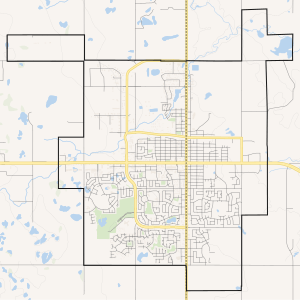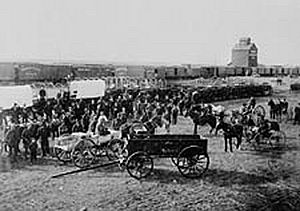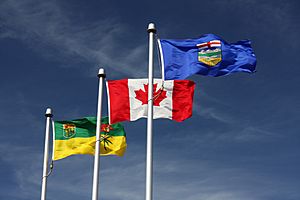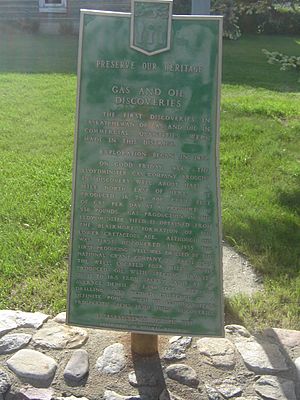Lloydminster facts for kids
Quick facts for kids
Lloydminster
|
|||
|---|---|---|---|
|
City
|
|||
| City of Lloydminster | |||

An aerial view of Lloydminster City Hall looking north along the Alberta / Saskatchewan border
|
|||
|
|||
| Nickname(s):
"Border City" or "Canada's Border City", "Heavy Oil Capital of Canada"
|
|||

Boundaries of Lloydminster
|
|||

Location in Alberta and Saskatchewan
|
|||
| Country | Canada | ||
| Provinces | Alberta (AB) Saskatchewan (SK) |
||
| Regions | Central Alberta, West Central Saskatchewan |
||
| Census divisions | 10 (AB), 17 (SK) | ||
| Adjacent municipal district | County of Vermilion River | ||
| Adjacent rural municipalities | RM of Wilton No. 472 RM of Britannia No. 502 |
||
| Incorporated | |||
| • Village (SK) | November 25, 1903 | ||
| • Village (AB) | July 6, 1906 | ||
| • Town (SK) | April 1, 1907 | ||
| • Amalgamation | May 22, 1930 | ||
| • City | January 1, 1958 | ||
| Area
(2021)
|
|||
| • Land | 42.04 km2 (16.23 sq mi) | ||
| Elevation | 645 m (2,116 ft) | ||
| Population
(2021)
|
|||
| • Total | 31,582 – 19,739 (AB) – 11,843 (SK) |
||
| • Density | 751.2/km2 (1,946/sq mi) | ||
| • Municipal census (2015) | 31,377 – 19,740 (AB) – 11,637 (SK) |
||
| Time zone | UTC−07:00 (MST) | ||
| • Summer (DST) | UTC−06:00 (MDT) | ||
| Forward sortation areas |
T9V (AB), S9V (SK)
|
||
| Area code(s) | 780, 587, 825, 368 (AB) 306, 639 (SK) |
||
Lloydminster is a unique city in Canada. It sits right on the border between two provinces: Alberta and Saskatchewan. This means the city is officially part of both provinces, but it has one single government that manages everything.
Before it was settled by Europeans, Lloydminster was the traditional home of several Indigenous groups. These included the Plains Cree, Wood Cree, Dene, Saulteaux, and the Métis people.
Contents
History of Lloydminster
Lloydminster was started in 1903 by a group of settlers from the United Kingdom. They were called the Barr Colonists. Their goal was to create a perfect British community where people lived a simple, sober life. At that time, the area was part of the Northwest Territories.
The town was built right on a special survey line called the Fourth Meridian. This line was supposed to be at 110° west longitude. However, because surveying methods weren't perfect back then, the actual line ended up a bit west of that exact spot.
The town was named after George Lloyd. He was an Anglican priest who helped the colonists during their difficult journey. He took over as leader from the original organizer, Isaac Montgomery Barr.
Lloydminster grew quickly. By 1904, it had a telegraph office and a church. In 1905, a local newspaper started, and the first train arrived. The main street, now called Meridian Avenue (or 50th Avenue), was built right on the Fourth Meridian. This street became the center for shops and businesses. For many years, alcohol was not allowed in Lloydminster, following the settlers' original principles.
In 1905, Alberta and Saskatchewan became provinces. The Fourth Meridian was chosen as the border, which cut Lloydminster right in half! Residents asked for the border to be changed so the whole town would be in Saskatchewan, but it didn't happen. So, Lloydminster operated as two separate towns with two different governments for a while.
Finally, in 1930, the provincial governments agreed to join the two towns into one. Then, in 1958, they officially made Lloydminster a single city under shared control.
To celebrate its special status, a monument with four tall survey markers was put up in 1994. It's located near the city center. For many years, most people lived on the Saskatchewan side. But by 2011, nearly two-thirds of the city's population lived on the Alberta side. In 2000, the city hall even moved from Saskatchewan to the Alberta side of Meridian Avenue.
Geography and the Border
The provincial border runs north to south, right along 50th Avenue (Meridian Avenue) in the middle of Lloydminster. If you're on the east side of 50th Avenue, you're in Saskatchewan. If you're on the west side, you're in Alberta! This means stores and businesses are on both sides of the border.
Time Zones and Communication
Lloydminster's unique location affects things like its time zone. Most of Saskatchewan doesn't use daylight saving time, staying on Central Standard Time all year. But Alberta does use daylight saving time. To keep things simple, Lloydminster's special rules allow the whole city to follow Alberta's time. This means during summer, the entire city is on Mountain Daylight Time. In winter, it's on Mountain Standard Time, which is one hour behind the rest of Saskatchewan.
The border also affects phone numbers and postal codes. If you have a phone on the Saskatchewan side, your number will start with area codes like 306 or 639. On the Alberta side, it will be 780, 587, or 825. Similarly, Saskatchewan postal codes start with "S9V," and Alberta postal codes start with "T9V."
Climate
Lloydminster has a climate with long, cold, and dry winters. Summers are shorter, warm, and a bit wet. The city doesn't get a lot of rain or snow overall.
The hottest temperature ever recorded in Lloydminster was 38.1°C (100.6°F) on July 12, 2002. The coldest temperature ever recorded was a very chilly -50.0°C (-58.0°F) on January 13, 1911.
| Climate data for Lloydminster Airport, 1981–2010 normals, extremes 1904–present | |||||||||||||
|---|---|---|---|---|---|---|---|---|---|---|---|---|---|
| Month | Jan | Feb | Mar | Apr | May | Jun | Jul | Aug | Sep | Oct | Nov | Dec | Year |
| Record high humidex | 10.4 | 8.2 | 18.6 | 27.1 | 34.7 | 39.0 | 42.5 | 38.4 | 32.8 | 26.5 | 16.3 | 9.5 | 42.5 |
| Record high °C (°F) | 10.6 (51.1) |
12.8 (55.0) |
18.6 (65.5) |
32.8 (91.0) |
36.7 (98.1) |
37.8 (100.0) |
38.1 (100.6) |
37.4 (99.3) |
35.0 (95.0) |
28.9 (84.0) |
19.5 (67.1) |
10.0 (50.0) |
38.1 (100.6) |
| Mean daily maximum °C (°F) | −9.6 (14.7) |
−6.9 (19.6) |
−1 (30) |
9.9 (49.8) |
16.7 (62.1) |
20.7 (69.3) |
23.1 (73.6) |
22.4 (72.3) |
16.5 (61.7) |
9.1 (48.4) |
−2.6 (27.3) |
−7.9 (17.8) |
7.5 (45.5) |
| Daily mean °C (°F) | −14.3 (6.3) |
−11.7 (10.9) |
−5.6 (21.9) |
4.0 (39.2) |
10.1 (50.2) |
14.6 (58.3) |
17.0 (62.6) |
15.9 (60.6) |
10.3 (50.5) |
3.4 (38.1) |
−6.8 (19.8) |
−12.5 (9.5) |
2.0 (35.6) |
| Mean daily minimum °C (°F) | −18.9 (−2.0) |
−16.6 (2.1) |
−10.3 (13.5) |
−2 (28) |
3.5 (38.3) |
8.5 (47.3) |
10.8 (51.4) |
9.3 (48.7) |
4.0 (39.2) |
−2.3 (27.9) |
−11 (12) |
−17 (1) |
−3.5 (25.7) |
| Record low °C (°F) | −50 (−58) |
−48.3 (−54.9) |
−36.7 (−34.1) |
−28.9 (−20.0) |
−16.7 (1.9) |
−6.7 (19.9) |
−3.3 (26.1) |
−5 (23) |
−13.9 (7.0) |
−24 (−11) |
−34.4 (−29.9) |
−46.7 (−52.1) |
−50 (−58) |
| Record low wind chill | −54.6 | −54.5 | −49.8 | −30.3 | −15.7 | −4.9 | 0.0 | −6.1 | −14.7 | −35.8 | −50.9 | −54 | −54.6 |
| Average precipitation mm (inches) | 15.8 (0.62) |
9.8 (0.39) |
14.4 (0.57) |
26.3 (1.04) |
44.6 (1.76) |
70.6 (2.78) |
75.3 (2.96) |
59.9 (2.36) |
42.3 (1.67) |
17.8 (0.70) |
17.6 (0.69) |
14.4 (0.57) |
408.8 (16.09) |
| Average rainfall mm (inches) | 0.4 (0.02) |
0.2 (0.01) |
1.6 (0.06) |
13.2 (0.52) |
40.8 (1.61) |
70.6 (2.78) |
75.3 (2.96) |
59.7 (2.35) |
40.5 (1.59) |
11.6 (0.46) |
2.3 (0.09) |
0.5 (0.02) |
316.7 (12.47) |
| Average snowfall cm (inches) | 17.0 (6.7) |
9.8 (3.9) |
13.4 (5.3) |
13.4 (5.3) |
4.2 (1.7) |
0.0 (0.0) |
0.0 (0.0) |
0.1 (0.0) |
1.8 (0.7) |
6.4 (2.5) |
16.7 (6.6) |
15.3 (6.0) |
98.1 (38.7) |
| Average precipitation days (≥ 0.2 mm) | 9.7 | 7.3 | 8.0 | 7.6 | 10.5 | 13.2 | 12.2 | 10.5 | 9.0 | 7.1 | 9.4 | 9.8 | 114.2 |
| Average rainy days (≥ 0.2 mm) | 0.7 | 0.1 | 1.1 | 4.8 | 9.9 | 13.2 | 12.2 | 10.5 | 8.7 | 4.9 | 1.3 | 0.6 | 68.0 |
| Average snowy days (≥ 0.2 cm) | 9.4 | 7.4 | 7.4 | 3.9 | 1.5 | 0.0 | 0.0 | 0.0 | 0.7 | 3.0 | 8.7 | 9.7 | 51.7 |
| Average relative humidity (%) | 74.2 | 73.0 | 67.4 | 48.2 | 42.4 | 49.6 | 53.9 | 50.2 | 50.0 | 54.0 | 73.3 | 75.9 | 59.3 |
| Source: Environment and Climate Change Canada | |||||||||||||
People of Lloydminster
| Federal census population history |
||
|---|---|---|
| Year | Pop. | ±% |
| 1906 | 519 | — |
| 1911 | 663 | +27.7% |
| 1916 | 788 | +18.9% |
| 1921 | 755 | −4.2% |
| 1926 | 1,247 | +65.2% |
| 1931 | 1,516 | +21.6% |
| 1936 | 1,420 | −6.3% |
| 1941 | 1,624 | +14.4% |
| 1946 | 1,833 | +12.9% |
| 1951 | 3,938 | +114.8% |
| 1956 | 5,077 | +28.9% |
| 1961 | 5,667 | +11.6% |
| 1966 | 7,071 | +24.8% |
| 1971 | 8,691 | +22.9% |
| 1976 | 10,311 | +18.6% |
| 1981 | 15,031 | +45.8% |
| 1986 | 17,356 | +15.5% |
| 1991 | 17,283 | −0.4% |
| 1996 | 18,953 | +9.7% |
| 2001 | 20,988 | +10.7% |
| 2006 | 24,028 | +14.5% |
| 2011 | 27,804 | +15.7% |
| 2016 | 31,410 | +13.0% |
| 2021 | 31,582 | +0.5% |
| Source: Statistics Canada |
||
In 2021, the total population of Lloydminster was 31,582 people. The Alberta side had 19,739 residents, and the Saskatchewan side had 11,843 residents.
Interestingly, the population on the Saskatchewan side is generally younger. The average age there is 26.6 years, while on the Alberta side it's 33.2 years. Lloydminster actually has the youngest average age of any city in Canada! One reason for this might be that car insurance rates are often cheaper in Saskatchewan for young drivers.
Languages and Backgrounds
Most people in Lloydminster (about 94%) speak English as their first language. A smaller number speak French, German, Ukrainian, or Cree.
In 2006, more than 8% of residents identified as Indigenous. The city is home to people from many different backgrounds, including those of European, Southeast Asian, South Asian, African, East Asian, Middle Eastern, and Latin American heritage.
Religions
In 2001, over 78% of people in Lloydminster identified as Christian. About 18% said they had no religious connection. Among Christians, many were Roman Catholic or Protestant, including those who identified with the United Church of Canada, Anglican, Lutheran, Pentecostal, Baptists, and Eastern Orthodox churches.
Economy
The main industry in Lloydminster is petroleum (oil and gas). Agriculture (farming) is also very important. The Husky Lloydminster Refinery, a large oil processing plant, is located here.
One interesting thing about businesses in Lloydminster is sales tax. Alberta only has the federal GST. Saskatchewan has GST plus a provincial sales tax (PST). To make sure businesses on the Saskatchewan side don't lose customers to Alberta, PST usually doesn't apply in the Saskatchewan part of Lloydminster. However, it does apply to hotels, vehicle registration, and utility services.
City Services and Transportation
Lloydminster has its own airport, Lloydminster Airport. The Yellowhead Highway (also known as Highway 16) goes through the city from west to east. Highway 17 runs along the provincial border from south to north. Both provinces help maintain Highway 17. Currently, there is no public bus system in the city.
Education
Schools on both sides of the border use Saskatchewan's school curriculum. Lloydminster offers public and Catholic schools for students up to grade 12. For students who want to continue their education, Lakeland College offers one- and two-year certificate and diploma programs.
Media
Newspapers
- Lloydminster Meridian Booster: This newspaper covers news for Lloydminster and the surrounding area. It is published three times a week.
- Lloydminster Source: This is a free newspaper published twice a week.
Radio Stations
| Frequency | Call sign | Branding | Format | Owner | Notes |
|---|---|---|---|---|---|
| AM 540 | CBK | CBC Radio One | Talk radio, public radio | Canadian Broadcasting Corporation | |
| FM 95.9 | CKSA-FM | Real Country 95.9 | Country music | Stingray Group | |
| FM 97.5 | CKUA-FM-15 | CKUA Radio | Variety, public radio | CKUA Radio Foundation | Rebroadcaster of CKUA-FM (Edmonton) |
| FM 98.9 | CILR-FM | – | Tourist information | Stingray Group | |
| FM 106.1 | CKLM-FM | 106.1 The Goat | Active rock | Vista Radio |
Television Stations
Lloydminster has two local TV stations, both owned by Newcap Radio:
| OTA virtual channel (PSIP) | OTA channel | Call sign | Network | Notes |
|---|---|---|---|---|
| 2.1 | 2 (VHF) | CKSA-DT | Citytv | Privately owned affiliate |
| 4.1 | 4 (VHF) | CITL-DT | CTV | Privately owned affiliate |
Famous People from Lloydminster
- Ron Adam – Canadian Football League (CFL) player
- Colby Armstrong – National Hockey League (NHL) player
- Calvin Ayre – founder of Bodog (an online company)
- Garnet "Ace" Bailey – NHL player and scout
- Leon Benoit – Canadian politician
- Samuel Delbert Clark – sociologist
- Joan Crockatt – Canadian politician and journalist
- Cory Cross – NHL player
- David Dziurzynski – NHL player
- Rosemarie Falk – Canadian politician
- Scott Hartnell – NHL player
- Braden Holtby – NHL goaltender
- Skip Krake – NHL player
- Clarke MacArthur – NHL player
- Lucella MacLean – AAGPBL utility player
- James Hanna McCormick – Northern Irish politician
- Keith Morrison – journalist and newscaster
- Wade Redden – NHL player
- Richard Starke – Canadian politician
- James Till – biophysicist who helped discover stem cells
- Lance Ward – NHL player
- Tyler Weiman – NHL goaltender
- Colleen Young – Saskatchewan politician
- Tanner Novlan – actor
See also
 In Spanish: Lloydminster para niños
In Spanish: Lloydminster para niños






